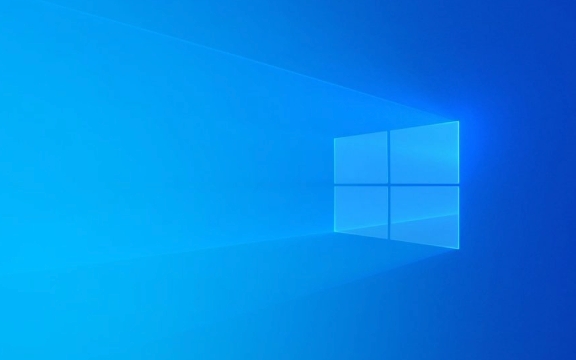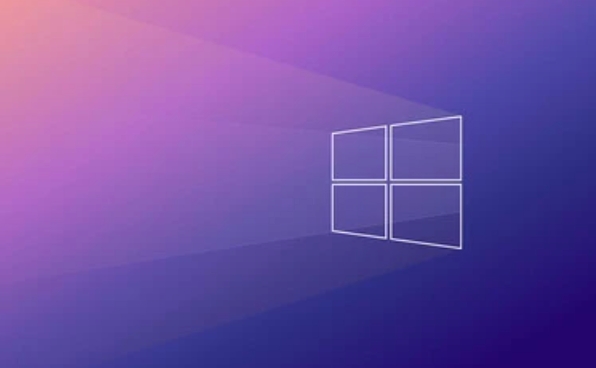How to fix 'No audio output device is installed' on Windows
Jul 02, 2025 am 10:24 AMWhen you encounter the prompt "No audio output device is installed", it means that Windows does not detect an audio device, and the problem is usually caused by the driver, settings, or hardware. 1. First check the sound settings and confirm whether the default playback device is correct and whether the volume is not muted; 2. Enter the device manager to update or reinstall the audio driver, and manually download and install it if necessary; 3. Run the Windows Sound Troubleshooting Tool to automatically troubleshoot problems; 4. Check the connection status of the external audio device, try to replace the headset or use a USB sound card to troubleshoot hardware failures. In most cases, it can be solved by setting the default device or updating the driver. If it still cannot be processed, it may be due to system files corruption or hardware problems. The system needs to be repaired further or after-sales support is contacted.

I encountered a prompt "No audio output device is installed", indicating that Windows cannot detect the available audio device. The problem is usually with the driver, system setup, or hardware connection. Here are some practical solutions.

1. Check sound settings and default devices
Sometimes the system does not set the correct device as the default playback device, or the volume is muted.

- Right-click the taskbar volume icon and click "Open Sound Settings".
- Check if there are devices listed (such as speakers or headphones) in the Sound Control Panel.
- If there are multiple devices, right-click to select "Set as default device".
- Make sure the gray "No Audio Device" is not displayed.
If no devices are seen here, further check for drivers or system updates may be required.
2. Update or reinstall the audio driver
The most common cause of this problem is an abnormal or missing audio driver.

- Press
Win Xand select Device Manager. - Expand Sound, Video, and Game Controllers.
- Right-click your audio device (such as Realtek High Definition Audio) and select "Update Driver".
- If no device is found, you can try right-clicking the category and select "Scan to detect hardware changes".
If you don’t find the right driver, you can go to the motherboard official website to download the corresponding audio driver installation.
3. Run the sound troubleshooting tool
Windows's own troubleshooting tools can sometimes automatically identify and fix audio problems.
- Open Settings > System > Sound.
- Scroll down and find "Run Sound Troubleshooting" under "Sound Settings".
- Follow the prompts and the system will try to find out the problem and provide repair suggestions.
Although this tool doesn't solve all the problems, it's worth a try, especially if you're not sure about the specific reason.
4. Check the hardware connection and physical device status
If you are using an external speaker or headset, first make sure that the connection is normal:
- Plug and unplug the audio cable once to make sure the plug is fully inserted.
- Replace different headphones or speakers to test it out to rule out the possibility of damage to the device itself.
- Try using a USB sound card. If it is a problem with the motherboard audio interface, you can temporarily bypass it.
In addition, some laptops have switching functions (such as headphones and microphones at the same time). You can use audio management software such as Realtek to check whether the current port mode is correct.
Basically these common ways of handling it. In most cases, updating the driver or resetting the default device can solve the problem. If it still doesn't work, it may be due to system files corruption or hardware failure. You can consider system repair or contact after-sales support.
The above is the detailed content of How to fix 'No audio output device is installed' on Windows. For more information, please follow other related articles on the PHP Chinese website!

Hot AI Tools

Undress AI Tool
Undress images for free

Undresser.AI Undress
AI-powered app for creating realistic nude photos

AI Clothes Remover
Online AI tool for removing clothes from photos.

Clothoff.io
AI clothes remover

Video Face Swap
Swap faces in any video effortlessly with our completely free AI face swap tool!

Hot Article

Hot Tools

Notepad++7.3.1
Easy-to-use and free code editor

SublimeText3 Chinese version
Chinese version, very easy to use

Zend Studio 13.0.1
Powerful PHP integrated development environment

Dreamweaver CS6
Visual web development tools

SublimeText3 Mac version
God-level code editing software (SublimeText3)
 How to reset the TCP/IP stack in Windows
Aug 02, 2025 pm 01:25 PM
How to reset the TCP/IP stack in Windows
Aug 02, 2025 pm 01:25 PM
ToresolvenetworkconnectivityissuesinWindows,resettheTCP/IPstackbyfirstopeningCommandPromptasAdministrator,thenrunningthecommandnetshintipreset,andfinallyrestartingyourcomputertoapplychanges;ifissuespersist,optionallyrunnetshwinsockresetandrebootagain
 What are the main pros and cons of Linux vs. Windows?
Aug 03, 2025 am 02:56 AM
What are the main pros and cons of Linux vs. Windows?
Aug 03, 2025 am 02:56 AM
Linux is suitable for old hardware, has high security and is customizable, but has weak software compatibility; Windows software is rich and easy to use, but has high resource utilization. 1. In terms of performance, Linux is lightweight and efficient, suitable for old devices; Windows has high hardware requirements. 2. In terms of software, Windows has wider compatibility, especially professional tools and games; Linux needs to use tools to run some software. 3. In terms of security, Linux permission management is stricter and updates are convenient; although Windows is protected, it is still vulnerable to attacks. 4. In terms of difficulty of use, the Linux learning curve is steep; Windows operation is intuitive. Choose according to requirements: choose Linux with performance and security, and choose Windows with compatibility and ease of use.
 How to troubleshoot a failed Windows installation
Aug 02, 2025 pm 12:53 PM
How to troubleshoot a failed Windows installation
Aug 02, 2025 pm 12:53 PM
VerifytheWindowsISOisfromMicrosoftandrecreatethebootableUSBusingtheMediaCreationToolorRufuswithcorrectsettings;2.Ensurehardwaremeetsrequirements,testRAMandstoragehealth,anddisconnectunnecessaryperipherals;3.ConfirmBIOS/UEFIsettingsmatchtheinstallatio
 How to enable Hyper-V in Windows
Aug 04, 2025 am 12:53 AM
How to enable Hyper-V in Windows
Aug 04, 2025 am 12:53 AM
Hyper-VcanbeenabledonWindowsPro,Enterprise,orEducationeditionsbymeetingsystemrequirementsincluding64-bitCPUwithSLAT,VMMonitorModeExtension,BIOS/UEFIvirtualizationenabled,andatleast4GBRAM.2.EnableHyper-VviaWindowsFeaturesbyopeningoptionalfeatures,chec
 How to solve touchpad not working issues on Windows?
Aug 05, 2025 am 09:21 AM
How to solve touchpad not working issues on Windows?
Aug 05, 2025 am 09:21 AM
Checkifthetouchpadisdisabledbyusingthefunctionkey(Fn F6/F9/F12),adedicatedtogglebutton,orensuringit’sturnedoninSettings>Devices>Touchpad,andunplugexternalmice.2.UpdateorreinstallthetouchpaddriverviaDeviceManagerbyselectingUpdatedriverorUninstal
 How to change screen resolution in Windows
Aug 02, 2025 pm 03:08 PM
How to change screen resolution in Windows
Aug 02, 2025 pm 03:08 PM
Right-clickthedesktopandselect"Displaysettings"toopenthedisplayoptions.2.Underthe"Display"section,clickthe"Displayresolution"dropdownandchoosearesolution,preferablytherecommendedoneforbestimagequality.3.Confirmthechanges
 how to fix 'the computer is not configured for a smart card' on a win pc
Aug 02, 2025 am 10:26 AM
how to fix 'the computer is not configured for a smart card' on a win pc
Aug 02, 2025 am 10:26 AM
EnsureSmartCard,SmartCardRemovalPolicy,andCertificatePropagationservicesarerunningandsettoAutomaticinservices.msc;2.InstallorupdatesmartcardreaderdriversviaDeviceManagerorthemanufacturer’swebsite,andinstallrequiredmiddlewarelikeActivClientorOpenSCifn
 How to fix 'The default gateway is not available' in Windows
Aug 02, 2025 am 06:54 AM
How to fix 'The default gateway is not available' in Windows
Aug 02, 2025 am 06:54 AM
RestartyourcomputerandroutertorefreshDHCPleasesandresetnetworkinterfaces.2.RuntheNetworktroubleshooterviaSettingstoautomaticallydetectandfixcommonissues.3.OpenCommandPromptasAdministratorandrunipconfig/release,ipconfig/renew,ipconfig/flushdns,netshwi






